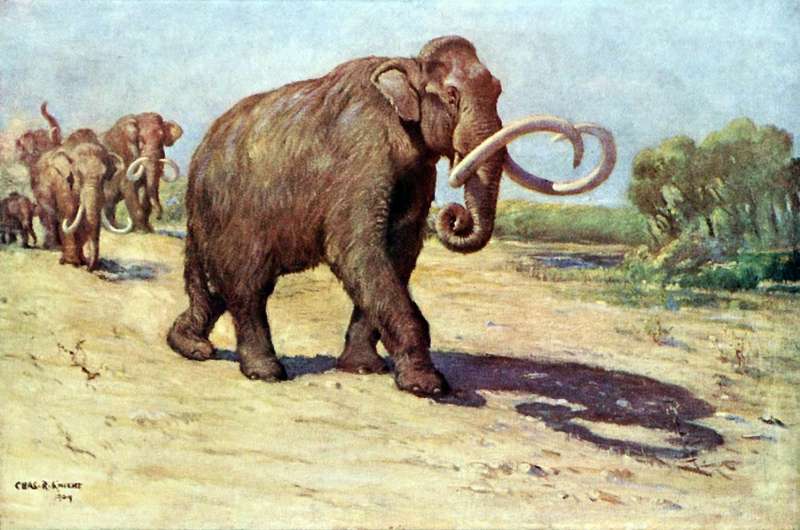The Columbian mammoth (Mammuthus columbi). Credit: Wikipedia.
(Phys.org)—A group of scientists from several institutions in Germany has suggested that extinct animals that are resurrected through scientific means be given a tag on their name to indicate their origins. In a Policy Forum piece in the journal Science, the group suggests adding the tag "recr" to scientific names given to resurrected creatures to make sure they are not confused with the original.
As technology improves, scientists often find themselves faced with addressing overlooked classification issues—scientific naming is no exception. As researchers develop new methods of bringing back extinct species or improving old techniques, the resultant organisms are very nearly copies of their extinct ancestors. Currently, there are three main resurrection methods. The first is back breeding, in which a species is bred over time to resemble a bygone species. Another is cloning, in which ancient reproductive material is placed in the uterus of a living close relative. Finally, there is genomic engineering, in which information that is missing from samples of a target species is filled in using DNA from a close modern relative. None of the techniques result in creation of a creature that is an exact copy of the original species, and that is at least partly why the authors suggest adding a tag to their names.
The authors give examples of how the new tag could be used, changing Mammuthus columbi to Mammuthus recr. columbi, for example. In some cases, if the new species is not a close copy of the original, the group suggests that a new species name be given, such as Mammuthus recr. Americanus.
The idea of changing the name of resurrected species is not new. The International Union for Conservation of Nature published guidelines three years ago offering possible ways to classify resurrected species. The authors with the new effort suggest a more standardized format. They suggest that not only will it make things less confusing for scientists, it will help environmentalists develop specific guidelines for preventing the species from going extinct again.
If the international community agrees with the suggestion and governing bodies move forward with the idea, there are still likely to be some issues that will be difficult to resolve. For instance, researchers want to determine how much extinct DNA in a living animal's genome qualifies for tagging. Also, some may not agree with the tag chosen because, as some in the field have already pointed out, current resurrections are not actually copies of ancient species—they are hybrids.
More information: De-extinction, nomenclature, and the law Science 09 Jun 2017: Vol. 356, Issue 6342, pp. 1016-1017 DOI: 10.1126/science.aal4012 , science.sciencemag.org/content/356/6342/1016
Summary
The concept of de-extinction, aimed at restoration of extinct species, is controversial (1). Improvements in de-extinction techniques (back-breeding, cloning, and genomic engineering) now provide the opportunity to attempt to resurrect extinct species (2, 3). Up to 25 extinct animal species have been proposed as candidates for de-extinction (4) on the basis of their high public profiles, availability of well-preserved DNA, existence of closely related species who may serve as host or surrogate parents, and availability of suitable habitat in the case of planned reintroductions (1). From a legal point of view, it will be crucial to clarify how de-extinct species will be classified, in particular, in relation to their potential conservation status under national and international law. We discuss implications for conservation laws, which largely depend on nomenclature, and laws regarding the release of genetically engineered species, which do not, and argue for unique naming of de-extinct species.
Journal information: Science
© 2017 Phys.org























